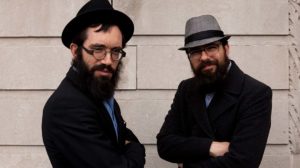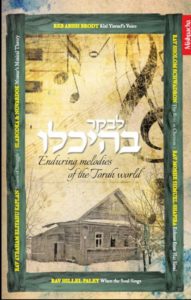The Art of Illustration


There’s a new phenomenon in the world of publishing today, an aesthetic, masterful revolution that began with a brushstroke and exploded in a flash of talent never glimpsed before. Behind it all is a name, Gadi Pollack. Meet the artist whose creations are keeping kids and adults spellbound.
“S
started off like all kids, coloring on walls. ‘Difference is, some kids stop; I never did.” This is signature Gadi Pollack, the man behind the paintbrush, whose wit, wisdom, and outstanding talent have raised the bar in Jewish literature to unprecedented heights. He’s honest and forthright. Before we meet for the interview, I am presented with a series of preconditions, including a ban on showing photographs of him and a directive to ensure the finished product features more pictures than text.
“Why don’t you want to be photographed?” I ask on the phone, even before setting foot in the comfortable Pollack dining room in Kiryat Sefer.
“I don’t want to lose my anonymity,” Gadi says simply.
We sit down at an ornate, wood-inlaid dining room table that looks … vaguely familiar. “You recognize it?” he asks. On second glance, I do. It’s the very table featured in the photographed front flap of his famous Once Upon a Tale series, sans the overlapped international passports and shadowy lighting. “All those passports are authentic; I added the names, each one written in its native language,” Gadi tells me proudly, revealing a lesser-known talent as a master forger.
We begin with the most obvious question: How did he get started in art and illustration? Gadi smiles wryly. “I was born in Odessa, Russia, and my whole family is musicians. There was no question whatsoever in anyone’s mind that I would be a musician too. Everyone played an instrument — trombone, piano, you name it. But I always loved to draw. I studied piano for four years, but at the age of ten I begged my father to let me go to Art school.”
At fifteen, Gadi went to Academia, the equivalent of university, to learn Art. “I wanted to get into Sculpture because that was the only course that didn’t require oil painting and I dislike working with oil. But I didn’t get in to the program so I went back home for a year and apprenticed a famous sculptor. The next year I reapplied and was accepted to Sculpture. I studied there for four years, then did my two years of mandatory army service. When I was conscripted, they lined us all up and the captain said, ‘You’re an artist? Go paint the fence!’ After half a year of training he put me in the army newspaper department, doing graphics.”
After serving in the Russian army, Gadi began working as an artist for an advertising company, but eventually his life path, led him to Israel, where he learned full-time in yeshivah, married, and then decided to begin illustrating books. “I started off by going to [famous illustrator] Yoni Gerstein and asked him to get me some clients, which he did. From there, I met Rabbi Boruch Chait and we started working together,” Gadi remembers. It’s a relatively straightforward story, to be sure, but the Divine Providence is anything but simple. From his very first book, Tell Me What You Think, the name “Gadi Pollack” became synonymous with lifelike, page-turning illustrations, the likes of which had never been glimpsed before in the Torah publishing world.
Artist of Many Colors
His art is breathtaking, but what’s truly fascinating about Gadi Pollack is his out-of-the-box, multi-genre acuity. He’s just as comfortable doing dramatic as he is at creating comic. His books run the gamut from The Art of Faith and Redemption Haggada, a sobering, heart-wrenching rendition of the Pesach saga, to PurimShpiel, an infectious, light-hearted treat. He illustrates for children and adults alike, often addressing both audiences in the same work. He even dabbles in the political and the philosophical. In his Tale of Seven Sheep, Gadi explores the Torah perspective on anti-Semitism, through a novel parable and deceptively comical illustrations. But perhaps he’s most famous for his Middos series, cocreated with Rabbi Baruch Chait. It’s this diversity and flexibility that keeps him challenged and delighted in what he does. “I don’t have one style; there’s nothing you can point to and say, ‘That’s classic Gadi Pollack! Every book is different because you have to match the illustration style to what fits. You match a technique to a subject.”
For the average reader, an illustrated page is just that — a pleasant picture to look at. For the illustrator himself, each page is a journey. The book begins as a kernel of an idea, which is then developed in “storyboard,” a crude montage of the proposed layout for each page. Then, a rough sketch of an illustration is made, which undergoes change after change, rendition following rendition, until it’s fine-tuned enough to be ready for color, shading, lighting, and then final polishing. Gadi pauses the interview and shifts into hands-on show-and-tell mode, reentering the dining room shlepping a hefty box.
“You see these?” He pulls out a thick sheaf of papers. “This is just one of the characters in the Middos series. It’s Rebbe Lev Tov.” The figure begins a bit plump with something not quite endearing enough in his eye. Over the next dozen pages, he gradually, magically takes shape. The beard gets fuller; the nose gets larger; spectacles are added; the stomach is redefined. Ah! The finished product is infinitely better than the first attempt. It’s the Rebbe Lev Tov we know and love. It’s perfect!
I am spellbound at the evolution of each and every character, from rough, one-dimensional scribbles to sharper pencil strokes. To watch the addition of washes, paints, shadows, and highlights is to watch an inanimate object come to life! The work is wearying, to be sure, but it is immensely thrilling, and Gadi’s animated expressions and demonstrations as he guides me through his work exude exactly that excitement.
All Hail the Gaavatanic!
Mention of the Middos series segues into a deeper look at how that highly successful project came about. It’s an interesting bird’s-eye view of the collaborative, delicate, painstaking journey, from idea to finished product, punctuated with tremendous siyata d’Shmaya and the lion’s share of late-night think sessions.
“These Middos series books are a classic lesson in how not to do books,” Gadi quips, with an easy, quiet smile. “Rabbi Chait approached me. He wanted to do a book on middos, something based on Orchos Tzaddikim. ‘How should we do it?’ I asked ‘We’ll see,’ he said. ‘Let’s think about it. First of all, read Orchos Tzaddikim.’ I read it. ‘Okay, what do we do now?’ I asked him. So he came up with an idea where each two-page spread would be a middah. We’d do ten good middos, ten bad middos. That came to twenty folios. Fine. Next, how would we do it? We came up with this idea of doing a tiyul, a trip, in the Land of Middos. Great! We’d have a Tower of Ga’avah, a Valley of Anavah, a Sea of Nedivut, and so on. We’d do a map of the whole place and everything would be wonderful. So I started drawing a Tower of Ga’avah, and I was trying to translate everything the Orchos Tzaddikim says into practical, contemporary examples. I sent it to Rabbi Chait, we worked on it a lot, and finally we finished this one illustration. Then, I get a call — at three in the morning. Now, I’m usually not sleeping then, but he is. He says, ‘Okay, I have an idea. It’s not going to be a tower, it’s going to be a boat. We’ll do the Titanic, because it’s the symbol of ga’avah! After that we’ll go into the rest of the stuff.’
“He brought me pictures of the Titanic, and I researched it endlessly. I knew that ship down to its last nail!” Gadi remembers, and indeed, his version, the Gaavatanic, bears an uncanny resemblance to its ill-fated pseudo-namesake. The idea was so bombastic that the pair decided to continue in the very same theme. “There was no storyboard, there was no plan; instead, there was … a book — three books, in fact. They just happened! After that, we had the idea of the pirates, and that Rebbe Lev Tov would be the pirate chief.” He relishes the experience for a moment, maybe with some bewilderment. “Usually I’m so organized, but with this book, we didn’t even know what it would turn out to be when we began!”
What it turned out to be, in fact, was a blockbuster bestseller, a book that has children riveted and parents enthralled, essentially a ground-breaking, highly contemporary manual on developing good middos. Mention the word “jealousy” in our house, and my children will chime in with a “Don’t be a Jealous Jake!”
Although not an official part of the Middos series, Gadi’s illustrations for My Friends-The Alef Beis, another masterful Pollack-Chait creation, brings to it the same sort of genius, teaching a wealth of Hebrew words through whimsical, humorous, and enthralling illustrations.
Man With a Mission
Did Gadi realize he was bringing the Jewish world something new and special when he started out illustrating? His dry smile speaks volumes. “I did some market research. Actually, everywhere I travel, the first thing I do is go to a secular bookstore and spend time in the children’s section, browsing what’s out there. And I found that many books in the Jewish market were comparatively very unsuccessful, not so appealing. Perhaps the reason is that there are very few professionally trained artists working for the chareidi market.” Clearly, Gadi is actively working to combat this problem.
He’s unique in that he’s a talented writer as well as an artist, and he mines his material from authentic Jewish sources — with a creative twist, of course. Gadi’s Once Upon a Tale series, which quickly became a beloved classic down to the latest and final release, The End of the Tale is a perfect example. “I thought, Why not take the stories that our gedolim created and make a book out of them? They already have lots of action, they’re interesting, and they each have a beautiful message. I immediately thought of the parables of the Dubno Maggid. I was intrigued by the idea of making the book so interesting that people would be drawn to open it so they could learn the importance of the Maggid’s valuable messages.” They may be the timeless, oft-repeated meshalim of the Dubno Maggid, but in Gadi’s hands, however, they become powerful, fresh, and completely ingenious.
Who hasn’t met Fishel the Fool, or Roger the Rogue, and walked away without a chuckle and plenty of food for thought? While the masterful illustrations are true eye-candy, it’s the abundant lessons, freely absorbed, that make all the difference . In magnificent, painstaking Gadi style, each image and building featured in the series is real, either drawn from memory of his childhood and youth in Odessa, or taken from photographs. And here’s an interesting insider tidbit: Zalman, the wealthy merchant in the parables, is modeled on none other than Baron Rothschild — take a second look!
The extensive research he does for each and every book is readily apparent. “For one of the books in the Once Upon a Tale series, I needed a model of a tall building in Yerushalayim because in one of the meshalim the character jumps off a building. I went to Rav Yisrael Gellis $$this has to be entered in or taken out, this bracketed piece$$[who is he?], and he suggested I portray a certain unique building on Rechov Yaffo, which has a sun dial on it.” You can see the building in the last book — and on Rechov Yaffo itself, still standing there. Gadi also included a fascinating history of the sun-dial at the bottom of the page, added for educational value, which is another delightful and defining feature of his works.
He gets material for his story and illustration ideas from the widest variety of sources imaginable, evidenced by the many diverse books that line the shelves of his cozy office, and the hours he spends in the otzer seforim. Even PurimShpiel, a book punctuated with jokes but rooted in concrete Midrashic sources, demanded extensive research, never mind the Haggadah, which required enormous preparation and study even before a single sketch was drawn.
A Poignant Problem
Despite his attempts at maintaining a modicum of anonymity, the artist is, of course, very much in the public eye, and sometimes the public’s eye is sore. His Haggadah project, spearheaded by Rabbi Baruch Chait but largely created by Gadi himself, earned top ratings — and its fair share of complaints about the graphic, depressing images portrayed within. “One lecturer told me that he bought the Haggadah, but he took out the page with the bloodied man,” Gadi says candidly, referring to one particular picture featuring a weary, beaten, bleeding Jew lifting his hands to heaven in a poignant display of helplessness. “When I started out on this Haggadah, I decided to do something different than what’s already out there. Typically, every artist illustrates haggados in exactly the same way, but I wanted to do something according to the way the Haggadah is brought down in the mekoros, because a lot of people don’t even know what’s written there.”
His tone becomes impassioned. “Usually, people sit around their Seder table, feeling smug and happy, but they don’t truly feel the galus. They don’t feel what Mitzrayim was really like. If you would ask people in the street, ‘What was worse? Auschwitz, or Mitzrayim?’ they don’t know. But the truth is, Mitzrayim was much worse. It was the ‘ima’ of the galuyos. And no one knows it! So I set out on a mission to really tell it like it was. In order to do that, I had to create difficult, graphic images, and people don’t like that.”
He explains the nuance and background to the project as only the artist could be privy to, the inner contemplations of the creative mind at work, constrained by reader expectations and a supreme effort to strike the right balance. “That bloodied man, his hat is actually reminiscent of Auschwitz, if you look closely. And as much as I did draw depressing pictures, I also had rachmanus on my readers. We know that at Matan Torah everyone present was healed. But the Midrash says that everyone who left Mitzrayim was a baal mum, disfigured in some way. For that reason, I was advised to take off a hand from my figures, or at least amputate a finger, to portray the reality of what really happened. But I just couldn’t.”
Before every project, Gadi tells me, he always consults with his rosh yeshivah, and the Haggadah was no different. “I discussed my idea, and I also mentioned that there were people who opposed my showing something so graphic in a Haggadah that children may be reading. The rosh yeshivah was adamant. ‘They should stop trying to be smarter than HaKadosh Baruch Hu!’ he cried. ‘The Torah says, ‘V’higadetah l’vinchah…’ (And you should tell your son). We have an obligation to retell the whole story to our children. HaKadosh Baruch Hu will take care that the sensitive souls of the children will not be damaged!’
“The whole purpose was to bring people into Mitzrayim, so they could really feel the galus. That’s why, if you look at the Haggadah, you’ll see it reflects night; it’s all darkness, which visually helps the reader to live the experience. You’ll notice that as we move towards the Geulah, the pages lighten, until, finally, at Kriyas Yam Suf, the artwork is all lit up and beautiful. That’s the idea,” he explains.
And while we’re discussing the Haggadah, Gadi fills me in on a story surrounding the project that sounds like a Pesach miracle in its own right.
“We had amazing Hashgachah pratis with the Haggadah — you could write a whole article on just the Haggadah!” he laughs. And then, remembering, he winces. “Half a year’s work got thrown out in one night with that Haggadah!” But back to the Hashgachah. “When my books go to print, I stand there and supervise the printing, to make sure all the colors come out exact and that everything runs smoothly. Well, after the Haggadah printed, I left to kollel. It was relatively close to Pesach and we were printing 10,000 copies. It should have been put on the ship with exactly enough time to get to America a week or two before Pesach. If we missed Pesach, obviously, then that would be the end of the Haggadah for this year!
“While I was in kollel, Rabbi Boruch Chait calls me up. We have a problem — a big problem. Someone flipped through the pages of the unbound books and discovered a terrible graphics mistake — Hallel was printed after Bircas HaMazon!
“Right then and there, we opened up 10,000 booklets, by hand, and now we had to print up new ones. The print shop refused to do it in the pre-Pesach rush, so we went to Tel Aviv. Then the books needed to still be bound and glued and sewn; after that, they needed covers. The container to America was scheduled to leave on Sunday; the books were just being sewn on Friday. No one thought this could happen in time. People said, ‘Why are you making yourselves crazy? You’re going to be miss the boat!” Rabbi Chait didn’t give up. He said ‘Hashem ya’azor,’ and told us to daven. The workers stopped gluing on covers a few hours before Shabbos, then continued working Motzaei Shabbos. At 5 a.m, the books weren’t finished yet so Rabbi Chait had no choice but to cancel the shipping company. We just weren’t going to make it; the ship was scheduled to leave at 12 noon. Finally, at 4 p.m., the whole project was finished, but it was just too late. The loss was colossal. We had missed out on Pesach. Now we needed to find warehouses to store the books till next year.
“Rabbi Chait started making his phone calls, but someone kept trying to click in persistently, on the other line. This ‘nudnik’ somehow got through. ‘So sorry, Rabbi, there was a port strike yesterday and the ship was delayed. Do you want to bring the books in tomorrow morning?’ It was amazing! We made it!”
Soul Art
If his mission statement could be condensed into one line, Gadi’s committed to pairing meaning with art; it’s the fingerprint behind each of his projects, the only common thread that runs through his work. “In a newspaper interview, I was once asked, ‘You’re an artist, but you use your talents to push religion. Don’t you think that art shouldn’t be hinged on any kind of ideology, that it has value all on its own?’ I asked the reporter, ‘Do you think ancient Egyptian art is art?’ ‘Yes,’ she said. ‘Greek art?’ ‘Yes.’ ‘Roman?’ ‘Yes.’ ‘Renaissance?’ ‘Of course!’ Then I said to her, ‘Well, then, I’m very sorry to tell you but all the artists — Michaelangelo, everyone — portrayed their ideology in their artwork. Art was never separate from ideology or religion. But now, when people don’t believe in anything any more and all the sacred cows have been slaughtered, there’s nothing to sell, so art started to be unconnected to anything of meaning.’
“I gave this reporter a parable: ‘There are two friends, each has a fork. Each one has a schnitzel on his fork. One friend finishes his schnitzel and starts to decorate his empty fork. He starts yelling at his friend who’s still eating, ‘Why are you debasing your fork!’ Is the fork a kli, a means to an end, or is it a matarah, an end-purpose in and of itself? That’s the crux of art. Is it a medium or is it a standalone end-product? For me, art is a kli, an opportunity to give over a message. I want to refresh people, to show them things that they already recognize, in a way they don’t recognize at all. Like what I did in Dubno Maggid series, like in the Haggadah, even in PurimShpiel.”
Between the deadlines, the labor-intensive processes, and the creative energy, it’s definitely not an easy job, but someone’s got to do it. Is there ever burnout? I ask. “Occasionally,” Gadi says. When he hits a hump, he takes a vacation to refresh himself, but sooner than later he’s back with a bang, eager to tackle a new project. His passion is summed up in this wryly related anecdote: “There was a time when I thought of leaving illustrating and considered learning full-time in kollel instead. I spoke to Yoni Gerstein, who told me he went to Rav Shach with the same plan. Rav Shach forbade him from stopping to illustrate, encouraging Yoni to continue to work for the tzibbur. Yoni was happy with the psak because he just can’t live without his art. That’s what I tell people when they ask me who should be an artist. I tell them whoever can live without it shouldn’t do it!”
He’s also used his flame of talent to light other candles, imbuing other artists with the how-to to set off on their own. Many of today’s highly successful and well-known illustrators are graduates of Gadi’s courses, including his protégé, Ruth Beifus, whose style is sometimes reminiscent of her teacher’s. And, like most artists, Gadi is an admitted perfectionist. “If I’m not happy with the way a project comes out, I won’t put my full name on it,” he reveals.
If you should happen to pass by the Pollack residence one evening, you’ll no doubt see the light in the small back office, which burns way past midnight. Gadi describes his schedule as: “Go to Shacharis, come home, work a little, sleep a little, kids come home, then go back to kollel, learn with my kids, daven, they go to sleep, and I work until four or five in the morning. When I’m really tired I’ll go to sleep at 3 a.m. Late at night there’s no noise, no telephones — geshmak!” Is his a stereotypical artist’s den, brimming with scrunched-up sketches and spattered with paint, or a neat, streamlined studio with organized shelves and state-of-the-art equipment? Hard to say, since Mrs. Pollack did a thorough number on the place before visitors were permitted entrance! But the sleek, glowing computer, the soft lighting, and a few stray papers lend an air of pervading calm that perhaps belies the frenzy of creative juices at work.
I try to probe for a glimpse of information on what new projects wait in the wings, but Gadi regretfully declines. He likes to bring in an element of surprise when a new book comes out, although he does treat us to a small taste of an upcoming book in the montage on page $$fill in – leave this comment in for the final proofreader please$$.
His mediums are as diverse as his styles and techniques, with pencil and acrylic paint being a readily recognizable favorite, and sometimes the use of computer enhancement to add dimension. His ready humor and natural enthusiasm not only infuse our conversation, but are the backbone of every project. And he is delightfully unpredictable, unrestrained by status quo. With Gadi, there’s no steady rule for anything, and every project is a new challenge. His ideas come from everywhere and everything; the only common thread that runs through them is novelty and a commitment to solid Torah values, conveyed through brilliant artwork.
His immense success is not coincidental, and the amazing siyata d’Shmaya he bears witness to, time and time again, leaves no room for doubt: Hashem holds the hand that holds that brush. And in a very real, very awe-inspiring way, the reader intuitively feels it too.
(Originally featured in Mishpacha, Issue 327)
Oops! We could not locate your form.













